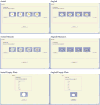Assessment of the accuracy of portion size reports using computer-based food photographs aids in the development of an automated self-administered 24-hour recall
- PMID: 20102828
- PMCID: PMC3773715
- DOI: 10.1016/j.jada.2009.10.007
Assessment of the accuracy of portion size reports using computer-based food photographs aids in the development of an automated self-administered 24-hour recall
Abstract
Objective: To assess the accuracy of portion-size estimates and participant preferences using various presentations of digital images.
Design: Two observational feeding studies were conducted. In both, each participant selected and consumed foods for breakfast and lunch, buffet style, serving themselves portions of nine foods representing five forms (eg, amorphous, pieces). Serving containers were weighed unobtrusively before and after selection as was plate waste. The next day, participants used a computer software program to select photographs representing portion sizes of foods consumed the previous day. Preference information was also collected. In Study 1 (n=29), participants were presented with four different types of images (aerial photographs, angled photographs, images of mounds, and household measures) and two types of screen presentations (simultaneous images vs an empty plate that filled with images of food portions when clicked). In Study 2 (n=20), images were presented in two ways that varied by size (large vs small) and number (4 vs 8).
Subjects/setting: Convenience sample of volunteers of varying background in an office setting.
Statistical analyses performed: Repeated-measures analysis of variance of absolute differences between actual and reported portions sizes by presentation methods.
Results: Accuracy results were largely not statistically significant, indicating that no one image type was most accurate. Accuracy results indicated the use of eight vs four images was more accurate. Strong participant preferences supported presenting simultaneous vs sequential images.
Conclusions: These findings support the use of aerial photographs in the automated self-administered 24-hour recall. For some food forms, images of mounds or household measures are as accurate as images of food and, therefore, are a cost-effective alternative to photographs of foods.
Copyright 2010 American Dietetic Association. Published by Elsevier Inc. All rights reserved.
Conflict of interest statement
Statement of Potential Conflict of Interest: No potential conflict of interest was reported by the authors.
Figures




Comment in
-
Advancing the art and science of dietary assessment through technology.J Am Diet Assoc. 2010 Jan;110(1):52-4. doi: 10.1016/j.jada.2009.10.014. J Am Diet Assoc. 2010. PMID: 20102827 No abstract available.
References
-
- Morgan S, Flint DM, Prinsley ML, Wahlqvisr ML, Parish AE. Measurement of food intake in the elderly by food photography. Proc Nutr Soc Aus. 1982;7:172.
-
- Chu SY, Kolonel LN, Hankin JH, Lee J. A comparison of frequency and quantitative dietary methods for epidemiologic studies of diet and disease. Am J Epidemiol. 1984;1189:323–333. - PubMed
-
- Guthrie HA. Selection and quantification of typical food portions by young adults. J Am Diet Assoc. 1984;12:1440–1444. - PubMed
-
- Samet JM, Humble CG, Skipper BE. Alternatives in the collection and analysis of food frequency interview data. Am J Epidemiol. 1983;120:572–581. - PubMed
-
- Byers T, Marshall J, Fiedler R, Zielezny M, Graham S. Assessing nutrient intake with an abbreviated dietary interview. Am J Epidemiol. 1985;122:41–49. - PubMed
Publication types
MeSH terms
Grants and funding
LinkOut - more resources
Full Text Sources
Other Literature Sources
Medical

